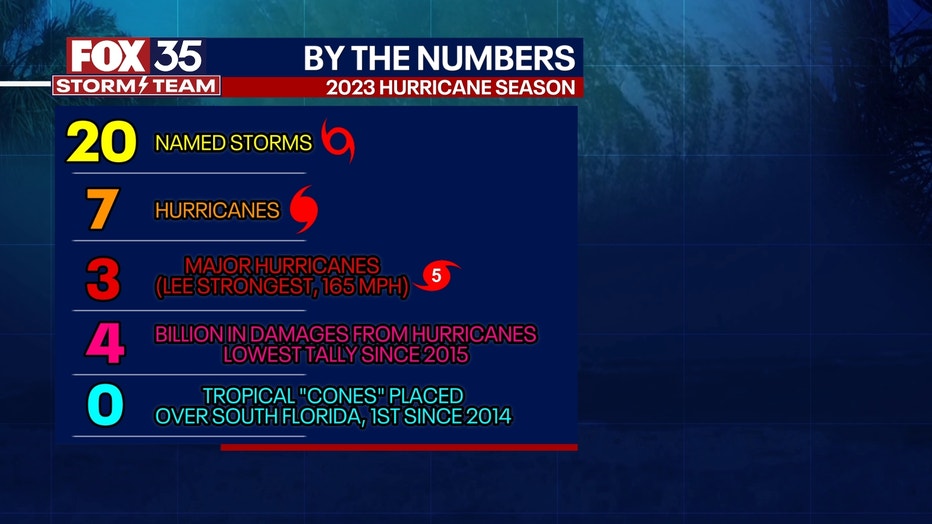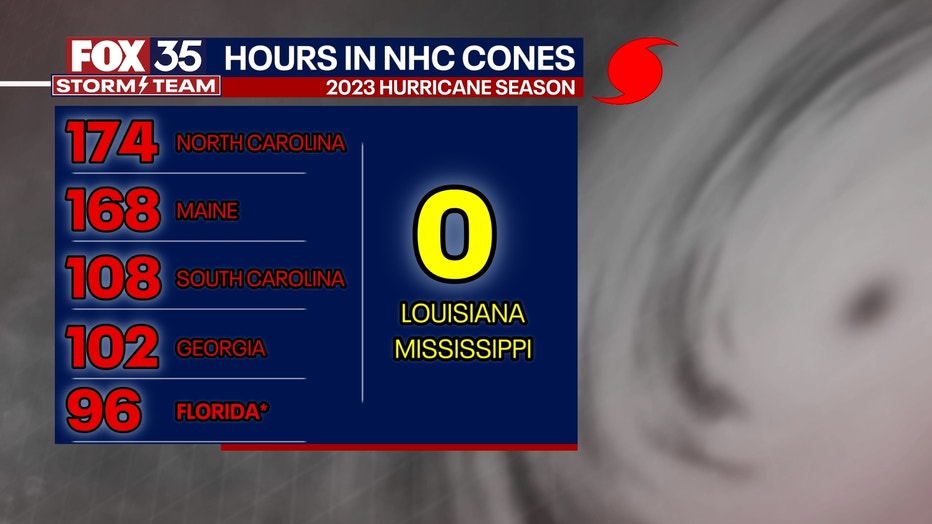Atlantic Hurricane Season 2023 recap: 1 landfalling hurricane and it hit Florida

2023 Atlantic Hurricane Season recap: 21 storms
FOX 35' meteorologist Noah Bergren looks back at the 2023 Atlantic Hurricane Season, including Hurricane Idalia, which made landfall over Florida's Big Bend region in August 2023. It was the fourth most active hurricane season since 1950.
While initially predicted to be a below-average hurricane season, the 2023 Atlantic Hurricane season actually flipped to an above-average season with 21 storms – 20 named and 1 unnamed --and three hurricanes – the fourth most-active hurricane season since 1950.
Record sea surface temperatures in the Atlantic Ocean and a strong El Nino – a naturally occurring weather pattern that involves warmer surface temps and a shift in the jet stream – are believed to have impacted this year's season.
This season also saw one landfalling hurricane in the U.S. – Hurricane Idalia, which struck Florida as a strong Category 3 hurricane near Keaton Beach on Aug. 30, 2022. Here's a brief recap of the season.

Atlantic Hurricane Season recap: A rare January start
The Atlantic Hurricane Season usually runs June 1 to Nov. 30, though it's possible for systems to form outside those timeframes – though, less common (arguably rare).
However, 2023 saw a rare subtropical system formed in on Jan. 16, 2023, about 300 miles north of Bermuda, according to the National Hurricane Center. The NHC decided to designate it as a subtropical system and the first storm of the season, however, did not give it a name.
It made the decision after doing a routine review of weather data and information.
So, how many storms did we see in the 2023 Atlantic Hurricane Season?
The 2023 Atlantic Hurricane Season saw 21 storms – 20 named and the rare unnamed January cyclone. There were seven hurricanes – three of which became major hurricanes, including Hurricane Idalia, which struck Florida.
The 2023 season is now the fourth most-active season since 1950. The average season typically sees 14 named storms, seven hurricanes, and three major hurricanes, the NHC said.

Here are the tropical storms and hurricanes that formed during the 2023 season
Out of the 21 storm names this year, 20 were used: Arlene, Bret, Cindy, Done, Emily, Franklin, Gert, Harold, Idalia, Jose, Katia, Lee, Margot, Nigel, Ophelia, Phillipe, Rina, Sean, and Tammy.
Only Vince and Whitney were not used. However, in November, there were a couple systems that were though to intensify enough to become a named storm. Ultimately, that did not happen.

Predictions: From below-average to above average
In April, Colorado State University initially predicted a slightly below-average season with 13 named storms, six hurricanes, and two major hurricanes, citing the uncertainty of the El Nino conditions, as well as statistical and historical data. However, in its June, July, and August predictions, chances increased to near-average and then above-average as a "robust El Nino" pattern had formed.
NOAA forecasters also increased their predictions regarding the season as El Nino better formed.
"The Atlantic basin produced the most named storms of any El Nino influenced year in the modern record," said Matthew Rosencrans, lead hurricane forecaster at NOAA’s Climate Prediction Center — a division of NOAA’s National Weather Service, in a prepared statement. "The record-warm ocean temperatures in the Atlantic provided a strong counterbalance to the traditional El Nino impacts."

Hurricane Idalia floods Crystal River
Hurricane Idalia caused major flooding in Crystal River Wednesday morning.
Hurricane Idalia
Hurricane Idalia struck Florida's Big Bend region around 7:45 a.m. on Aug. 30 as a Category 3 Hurricane with 125 mph sustained winds. It's was the first-ever major hurricane to make landfall in that particular region of Big Bend, according to the National Weather Service.
The hurricane brought 7-12 feet of storm surge across Levy, Taylor, and Dixie counties' coastal communities, causing extensive flooding and damaged to trees, buildings, and homes there.
Idalia started as an area of disturbed weather on Aug. 23 near Central America. It then moved across the northwestern Caribbean, where it became a tropical depression on Aug. 26. On Sunday, Aug. 27, it became Tropical Storm Idalia. Over the course of several hours, Idalia rapidly intensified into a hurricane.
After making landfall, Idalia spread across northern Florida and actually made its way across southwestern Georgia.
2023 Hurricane Season: By the numbers


When is the 2024 Atlantic Hurricane Season?
Hurricane season is back June 1, 2024 - November 30, 2024. Colorado State University is expected to put out its early season predictions sometime in April 2024, followed by the National Hurricane Center.

